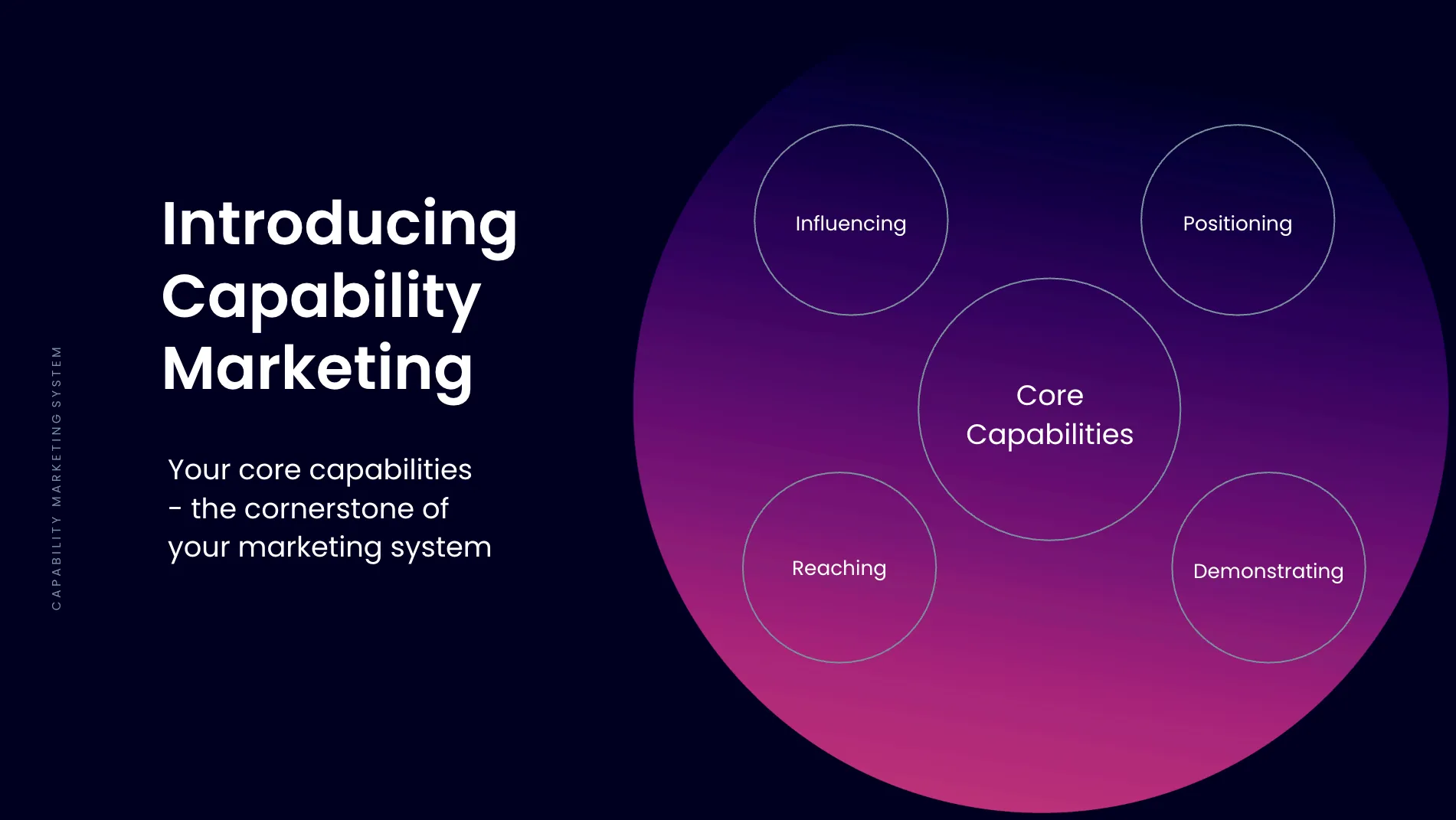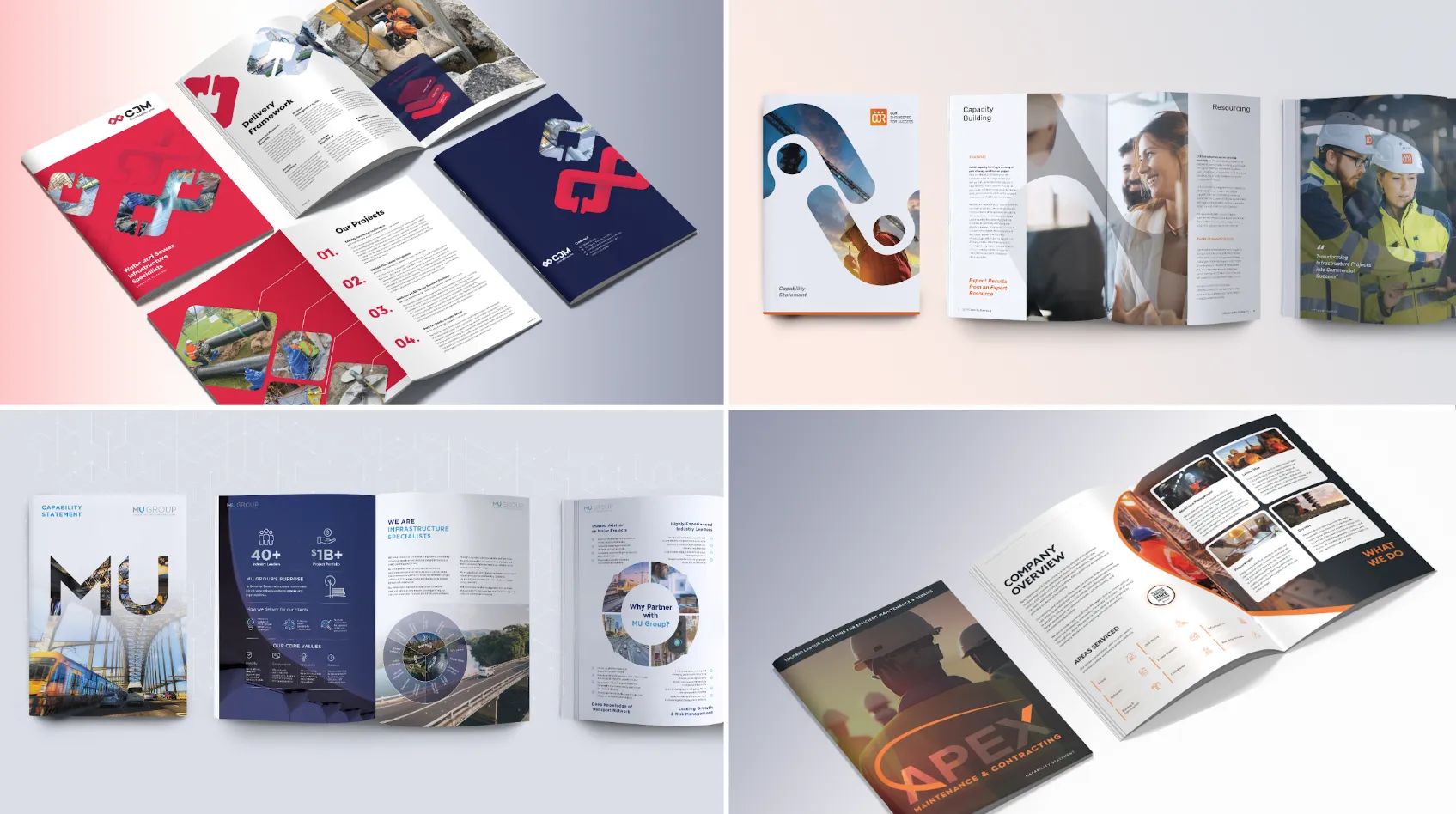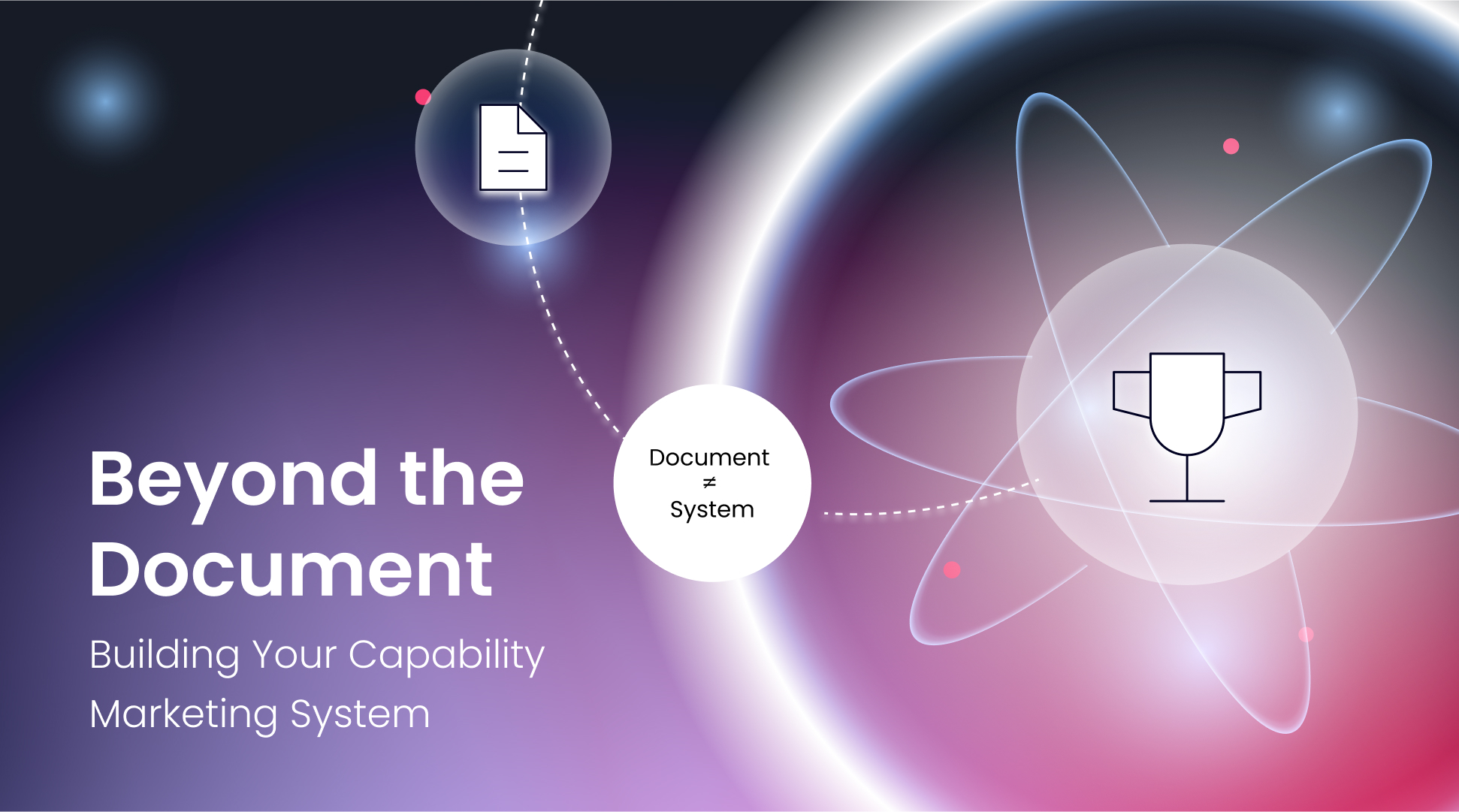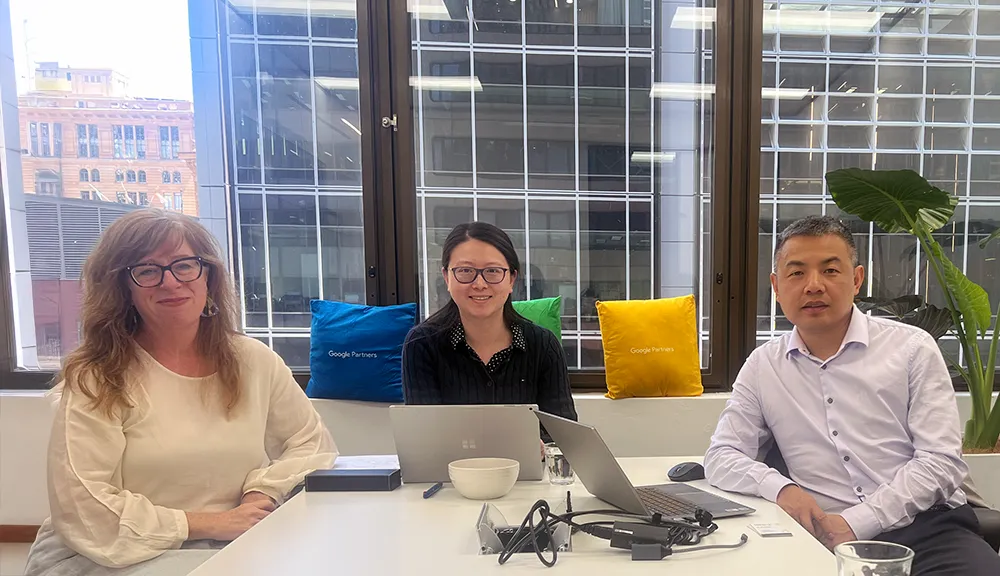When construction companies reach the point where they’re ready to scale — armed with sophisticated systems, proven track records, and often millions in equipment — they face an unexpected challenge. Despite having evolved far beyond their humble beginnings, they’re still telling the same simple story they told years ago, trapped by a perception gap that’s costing them opportunities.
This was the reality Mackey Kandarajah addressed in Spark Interact’s second webinar in their capability statement series, “Beyond the Document: Building Your Capability Marketing System.” While the first session covered the fundamentals of creating a capability statement, this follow-up transformed that foundation into something far more powerful: a complete marketing system designed for winning work in the modern construction industry.
Watch the full “Beyond the Document: Building Your Capability Marketing System” webinar recording below for detailed strategies on transforming your capability statement into a comprehensive marketing system.
The Three-Legged Chair Dilemma
“When companies come to us, they’re usually at what we call the launch pad stage,” Mackey explained to the attendees joining from across Australia on a Friday afternoon. “They’re ready to blast off to the next level, but they’re missing something crucial.”
He described what Spark Interact calls the “three-legged chair dilemma.” Most established construction businesses have three legs firmly in place: proven skills and capabilities, strong business relationships, and an impressive track record. But without the fourth leg — professional presentation and communication — the entire structure remains unstable.
The examples Mackey shared resonated with attendees. Companies with 50 employees and several million dollars worth of equipment were still describing themselves the way they did when they were a five-person operation. Long-term clients who’d worked with them for a decade suddenly needed capability statements, not because they doubted the work quality, but because compliance processes now demanded documentation that could travel up the chain to CFOs and CEOs who’d never set foot on a job site.
“The person that’s got the contract knows you can do the job. But as more administrative and compliance processes have come in, they’re having to pass these documents upline to CFOs, COOs, and CEOs who are looking to see if you’re ticking all the boxes.”
Mackey Kandarajah, Founder
Beyond Word-of-Mouth: The New Reality
The session acknowledged an uncomfortable truth for many in the construction industry: while word-of-mouth remains the gold standard for winning work, it’s no longer sufficient on its own. The shift toward subcontracting models means companies no longer hold labour or equipment directly — they’re constantly assembling teams for specific projects. In this environment, demonstrating capability to mitigate risk has become paramount.
But the perception gap affects more than just winning tenders. Mackey highlighted a challenge that struck a chord with many attendees: attracting talent. “People are trying to attract the right staff, but companies aren’t presenting themselves in a way that matches employee ambitions,” he noted. Potential employees with big aspirations look at outdated company presentations and conclude the business won’t support their growth — even when the reality is completely different.
The Four Pillars of Capability Marketing
The webinar then shifted from identifying problems to building solutions. Mackey introduced the Capability Marketing System, built on four interconnected pillars that transform static capability statements into dynamic business development tools.

Positioning: Defining Your True Identity
The first pillar focuses on how companies define and communicate who they really are — not just what they do, but what makes them different. Mackey shared the transformation of Hatanga, a Solomon Islands-based construction company operating in a complex geopolitical environment with Australian, New Zealand, and Chinese interests all vying for influence.
“They came to us saying they were probably one of the biggest companies in the country and wanted to win defense contracts from all these different places,” Mackey explained. The solution wasn’t just updating their capability statement — it was repositioning their entire brand to reflect their true scale and sophistication, from visual identity to messaging consistency across all touchpoints.
Demonstrating: Proving Your Capability
The second pillar moves beyond claiming capabilities to proving them convincingly. Using RA Smith, a Sydney-based excavation company, as an example, Mackey showed how demonstrating capability meant more than just listing completed projects.
“Showing images of excavation is great, but showing the scale at which things are being done is what really matters,” he emphasised. The capability statement, website, and all marketing materials needed to convey not just the work itself, but the complexity and scale that procurement teams care about — the ability to work seamlessly within multi-trade environments without creating problems for project managers.
Reaching: Consistent Visibility
The third pillar addresses the challenge of staying visible to decision-makers across multiple channels. Both Hatanga and RA Smith received comprehensive social media template guides, enabling their teams to maintain brand consistency without heavy design requirements.
“The audience needs to see this messaging repeatedly,” Mackey explained, outlining a multi-channel approach including social media posts, email campaigns, LinkedIn thought leadership, and Google Business Profile updates. Importantly, he noted that email lists don’t need to be massive — quality matters more than quantity when reaching existing customers and prospects who are genuinely interested in your capabilities.
Influencing: Shaping Perception Over Time
The fourth pillar recognises that changing market perception doesn’t happen overnight. Through thought leadership articles, white papers, guides, networking events, and community initiatives, companies gradually position themselves as industry leaders rather than just service providers.
“You find subject matter that’s really relevant and share it across LinkedIn, create downloadable guides for your website, hold seminars — even if it’s just inviting clients to a restaurant where you present your capabilities,” Mackey suggested, emphasising that influence builds through consistent, valuable contributions to industry conversations.
Making It Manageable
When asked about implementation — a critical concern for companies without dedicated marketing teams — Mackey offered practical solutions. In smaller companies, tasks could be distributed among team members: one person manages social media, another writes articles, someone else compiles email campaigns. The key is coordination and consistency, not perfection.
For companies needing more support, Spark Interact offers their Brand Engagement Program, managing everything from content creation to social media posting to email campaigns. But Mackey stressed that companies could start implementing the system themselves, building gradually from the foundation of their capability statement.
When pressed to prioritise the four pillars, Mackey advised starting with positioning: “It’s the visual element of the brand — the first impression. Once you get that consistency across channels, you can build on the other elements.” Demonstrating capability came second, with reaching and influencing flowing naturally once content and case studies were in place.
The Transformation in Action
Throughout the session, the transformation stories of Hatanga and RA Smith illustrated the power of the systematic approach. These weren’t just companies with updated capability statements — they were businesses that had transformed how they presented themselves across every customer touchpoint, from initial tender responses to social media presence to email communications.
The consistency was key. Every document generated, every social post published, every email sent reinforced the same professional image and core messages. This created what Mackey called “a seamless journey for that customer in terms of their experience and touchpoints with your organisation.”

Moving Forward: From Foundation to System
As the webinar concluded, the message was clear: a capability statement is just the beginning. In today’s construction industry, where compliance demands documentation and competition requires differentiation, companies need more than a single document — they need a complete marketing system that consistently communicates their true capabilities across all channels.
The perception gap between what companies have become and how they’re still seen represents both a challenge and an opportunity. By building on the foundation of a strong capability statement with systematic positioning, demonstrating, reaching, and influencing, construction companies can finally close that gap and compete for the larger, more stable contracts that match their true capabilities.
For attendees ready to take action, the path forward was clear: start with positioning and visual consistency, add demonstration through case studies and project showcases, then expand into reaching and influencing through consistent multi-channel marketing. It’s not about doing everything at once — it’s about building systematically from that capability statement foundation toward a complete marketing system that wins work.
Your Free Resources: Everything You Need to Get Started
As promised during the webinar, here are the valuable resources to help you build your capability marketing system — completely free with registration:
📊 Capability Marketing Assessment Tool
Evaluate your current approach across all four pillars and identify gaps. This comprehensive checklist helps you see exactly where your business is strong and where opportunities are being left on the table.
Download the Assessment Tool →
📱 Digital Marketing Checklist for B2B Companies
A step-by-step guide to building your online presence strategically. Stop wasting time on generic tactics and focus on what actually drives results for B2B companies in construction and professional services.
💼 LinkedIn Strategy Guide for Professional Services
Proven tactics for reaching decision-makers in your industry. Learn the 3-P Framework (Profile, Presence, Pipeline) designed specifically to help you penetrate target accounts and convert connections into contracts.
📄 Template Library Access
Professional templates for proposals, case studies, and project showcases. Get instant access to the templates that help you maintain consistency and professionalism across all your marketing materials.
Total value: $497 — yours free with webinar registration.
These resources give you everything needed to start implementing the four-pillar system immediately. Whether you’re beginning with positioning and visual consistency or ready to build your complete marketing system, these tools will guide you step by step.
Ready to accelerate your capability marketing transformation? Contact Spark Interact to discuss how our Brand Engagement Program can help you implement these strategies with expert support.





